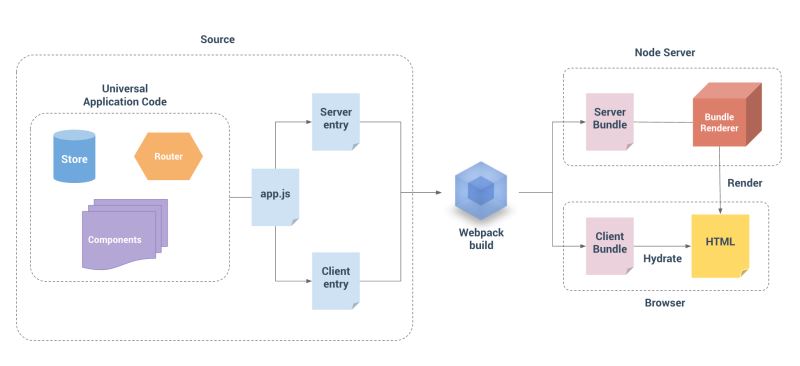您好,登錄后才能下訂單哦!
您好,登錄后才能下訂單哦!
http://mgyongyosi.com/2016/Vuejs-server-side-rendering-with-aspnet-core/
原作者:Mihály Gyöngyösi
譯者:oopsguy.com
我真的很喜歡在前端使用 Vue.js,Vue 服務端渲染直到第二個版本才被支持。 在本例中,我想展示如何將 Vue.js 服務端渲染功能整合 ASP.NET Core。 我們在服務端使用了 Microsoft.AspNetCore.SpaServices 包,該包提供 ASP.NET Core API,以便于我們可以使用上下文信息調用 Node.js 托管的 JavaScript 代碼,并將生成的 HTML 字符串注入渲染頁面。
在此示例中,應用程序將展示一個消息列表,服務端只渲染最后兩條消息(按日期排序)。可以通過點擊“獲取消息”按鈕從服務端下載剩余的消息。
項目結構如下所示:
. ├── VuejsSSRSample | ├── Properties | ├── References | ├── wwwroot | └── Dependencies ├── Controllers | └── HomeController.cs ├── Models | ├── ClientState.cs | ├── FakeMessageStore.cs | └── Message.cs ├── Views | ├── Home | | └── Index.cshtml | └── _ViewImports.cshtml ├── VueApp | ├── components | | ├── App.vue | | └── Message.vue | ├── vuex | | ├── actions.js | | └── store.js | ├── app.js | ├── client.js | ├── renderOnServer.js | └── server.js ├── .babelrc ├── appsettings.json ├── Dockerfile ├── packages.json ├── Program.cs ├── project.json ├── Startup.cs ├── web.config ├── webpack.client.config.js └── webpack.server.config.js
正如你看到的,Vue 應用位于 VueApp 文件夾下,它有兩個組件、一個包含了一個 mutation 和一個 action 的簡單 Vuex store 和一些我們接下來要討論的其他文件:app.js、client.js、 renderOnServer.js、server.js。
實現 Vue.js 服務端渲染

要使用服務端渲染,我們必須從 Vue 應用創建兩個不同的 bundle:一個用于服務端(由 Node.js 運行),另一個用于將在瀏覽器中運行并在客戶端上混合應用。
app.js
引導此模塊中的 Vue 實例。它由兩個 bundle 共同使用。
import Vue from 'vue';
import App from './components/App.vue';
import store from './vuex/store.js';
const app = new Vue({
store,
...App
});
export { app, store };
server.js
此服務端 bundle 的入口點導出一個函數,該函數有一個 context 屬性,可用于從渲染調用中推送任何數據。
client.js
客戶端 bundle 的入口點,其用一個名為 INITIAL_STATE 的全局 Javascript 對象(該對象將由預渲染模塊創建)替換 store 的當前狀態,并將應用掛載到指定的元素(.my-app)。
import { app, store } from './app';
store.replaceState(__INITIAL_STATE__);
app.$mount('.my-app');
Webpack 配置
為了創建 bundle,我們必須添加兩個 Webpack 配置文件(一個用于服務端,一個用于客戶端構建),不要忘了安裝 Webpack,如果尚未安裝,則:npm install -g webpack。
webpack.server.config.js
const path = require('path');
module.exports = {
target: 'node',
entry: path.join(__dirname, 'VueApp/server.js'),
output: {
libraryTarget: 'commonjs2',
path: path.join(__dirname, 'wwwroot/dist'),
filename: 'bundle.server.js',
},
module: {
loaders: [
{
test: /\.vue$/,
loader: 'vue',
},
{
test: /\.js$/,
loader: 'babel',
include: __dirname,
exclude: /node_modules/
},
{
test: /\.json?$/,
loader: 'json'
}
]
},
};
webpack.client.config.js
const path = require('path');
module.exports = {
entry: path.join(__dirname, 'VueApp/client.js'),
output: {
path: path.join(__dirname, 'wwwroot/dist'),
filename: 'bundle.client.js',
},
module: {
loaders: [
{
test: /\.vue$/,
loader: 'vue',
},
{
test: /\.js$/,
loader: 'babel',
include: __dirname,
exclude: /node_modules/
},
]
},
};
運行 webpack --config webpack.server.config.js, 如果運行成功,則可以在 /wwwroot/dist/bundle.server.js 找到服端 bundle。獲取客戶端 bundle 請運行 webpack --config webpack.client.config.js,相關輸出可以在 /wwwroot/dist/bundle.client.js 中找到。
實現 Bundle Render
該模塊將由 ASP.NET Core 執行,其負責:
渲染我們之前創建的服務端 bundle
將 **window.__ INITIAL_STATE__** 設置為從服務端發送的對象
process.env.VUE_ENV = 'server';
const fs = require('fs');
const path = require('path');
const filePath = path.join(__dirname, '../wwwroot/dist/bundle.server.js')
const code = fs.readFileSync(filePath, 'utf8');
const bundleRenderer = require('vue-server-renderer').createBundleRenderer(code)
module.exports = function (params) {
return new Promise(function (resolve, reject) {
bundleRenderer.renderToString(params.data, (err, resultHtml) => { // params.data is the store's initial state. Sent by the asp-prerender-data attribute
if (err) {
reject(err.message);
}
resolve({
html: resultHtml,
globals: {
__INITIAL_STATE__: params.data // window.__INITIAL_STATE__ will be the initial state of the Vuex store
}
});
});
});
};
實現 ASP.NET Core 部分
如之前所述,我們使用了 Microsoft.AspNetCore.SpaServices 包,它提供了一些 TagHelper,可輕松調用 Node.js 托管的 Javascript(在后臺,SpaServices 使用 Microsoft.AspNetCore.NodeServices 包來執行 Javascript)。
Views/_ViewImports.cshtml
為了使用 SpaServices 的 TagHelper,我們需要將它們添加到 _ViewImports 中。
@addTagHelper "*, Microsoft.AspNetCore.SpaServices"
Home/Index
public IActionResult Index()
{
var initialMessages = FakeMessageStore.FakeMessages.OrderByDescending(m => m.Date).Take(2);
var initialValues = new ClientState() {
Messages = initialMessages,
LastFetchedMessageDate = initialMessages.Last().Date
};
return View(initialValues);
}
它從 MessageStore(僅用于演示目的的一些靜態數據)中獲取兩條最新的消息(按日期倒序排序),并創建一個 ClientState 對象,該對象將被用作 Vuex store 的初始狀態。
Vuex store 默認狀態:
const store = new Vuex.Store({
state: { messages: [], lastFetchedMessageDate: -1 },
// ...
});
ClientState 類:
public class ClientState
{
[JsonProperty(PropertyName = "messages")]
public IEnumerable<Message> Messages { get; set; }
[JsonProperty(PropertyName = "lastFetchedMessageDate")]
public DateTime LastFetchedMessageDate { get; set; }
}
Index View
最后,我們有了初始狀態(來自服務端)和 Vue 應用,所以只需一個步驟:使用 asp-prerender-module 和 asp-prerender-data TagHelper 在視圖中渲染 Vue 應用的初始值。
@model VuejsSSRSample.Models.ClientState <!-- ... --> <body> <div class="my-app" asp-prerender-module="VueApp/renderOnServer" asp-prerender-data="Model"></div> <script src="~/dist/bundle.client.js" asp-append-version="true"></script> </body> <!-- ... -->
asp-prerender-module 屬性用于指定要渲染的模塊(在我們的例子中為 VueApp/renderOnServer)。我們可以使用 asp-prerender-data 屬性指定一個將被序列化并發送到模塊的默認函數作為參數的對象。
您可以從以下地址下載原文的示例代碼:
http://github.com/mgyongyosi/VuejsSSRSample
總結
以上所述是小編給大家介紹的Vue.js與 ASP.NET Core 服務端渲染功能整合,希望對大家有所幫助,如果大家有任何疑問請給我留言,小編會及時回復大家的。在此也非常感謝大家對億速云網站的支持!
免責聲明:本站發布的內容(圖片、視頻和文字)以原創、轉載和分享為主,文章觀點不代表本網站立場,如果涉及侵權請聯系站長郵箱:is@yisu.com進行舉報,并提供相關證據,一經查實,將立刻刪除涉嫌侵權內容。